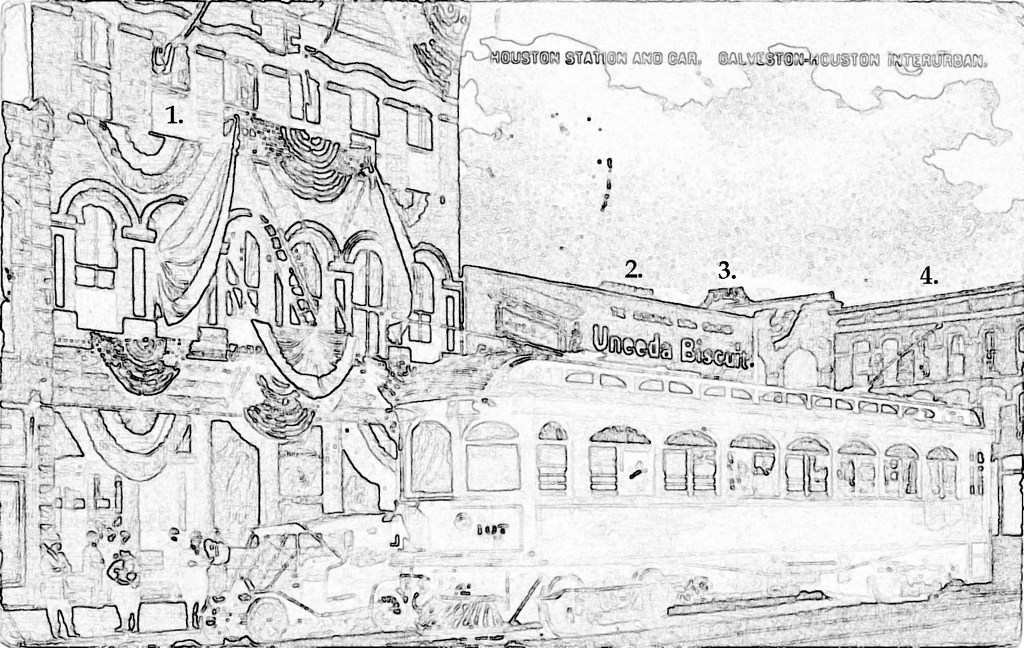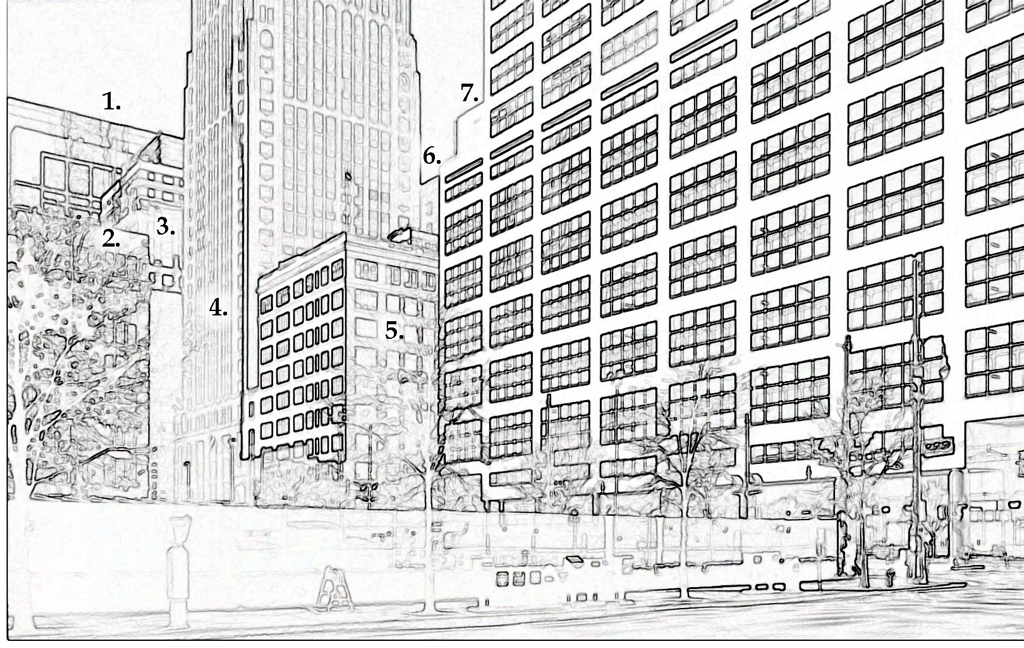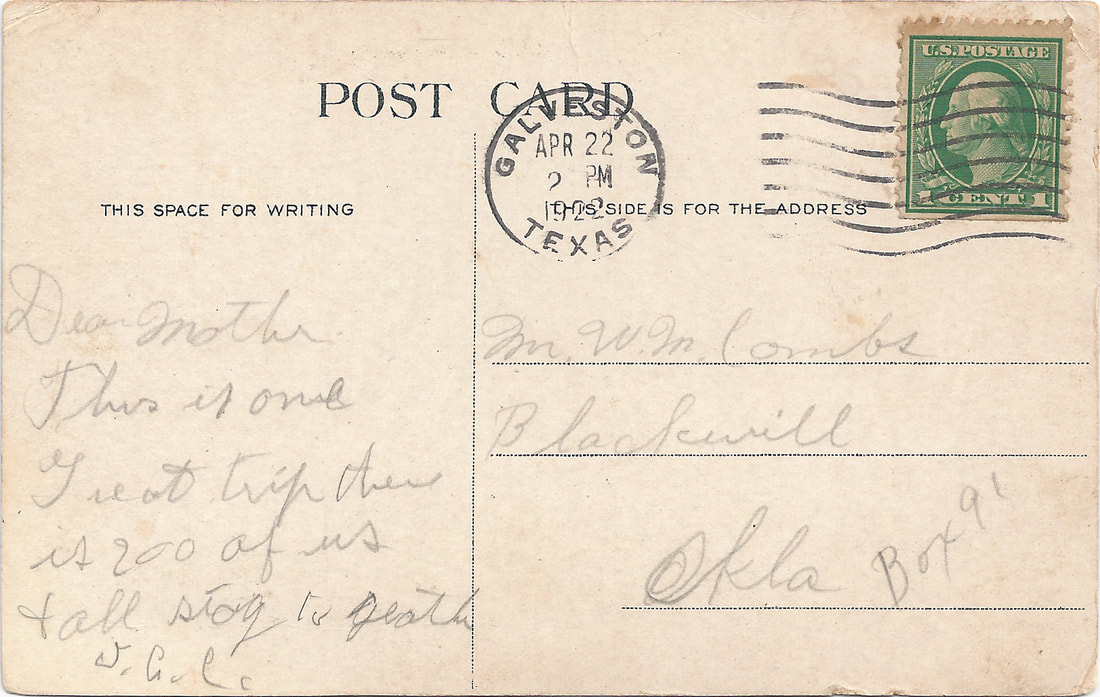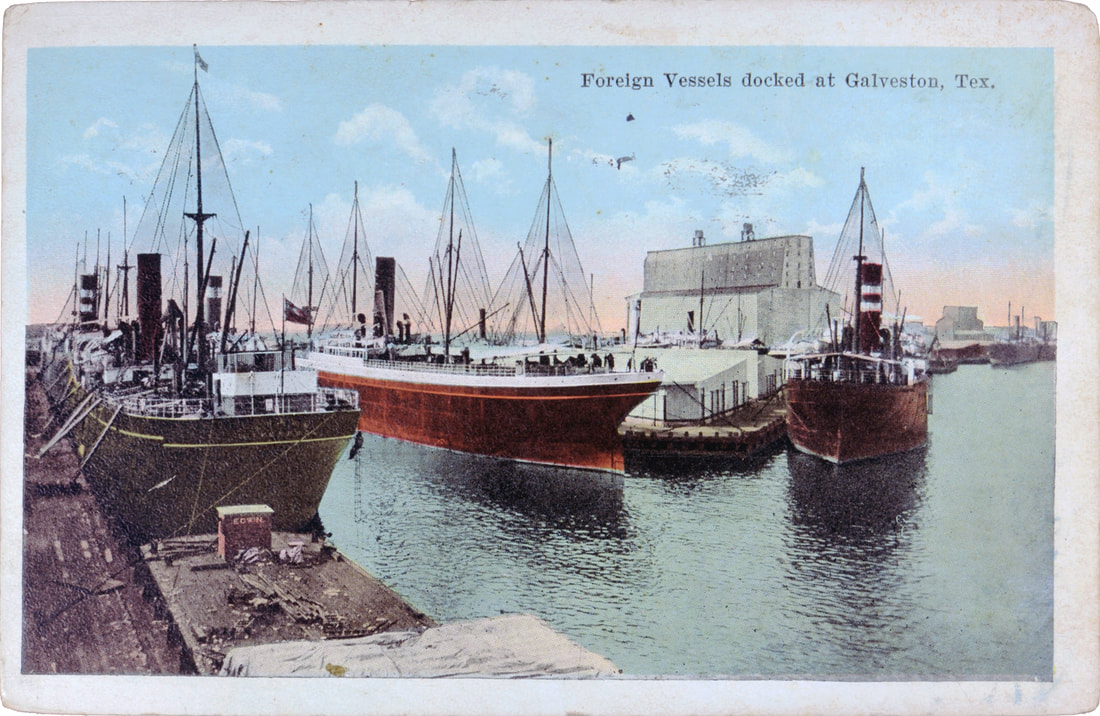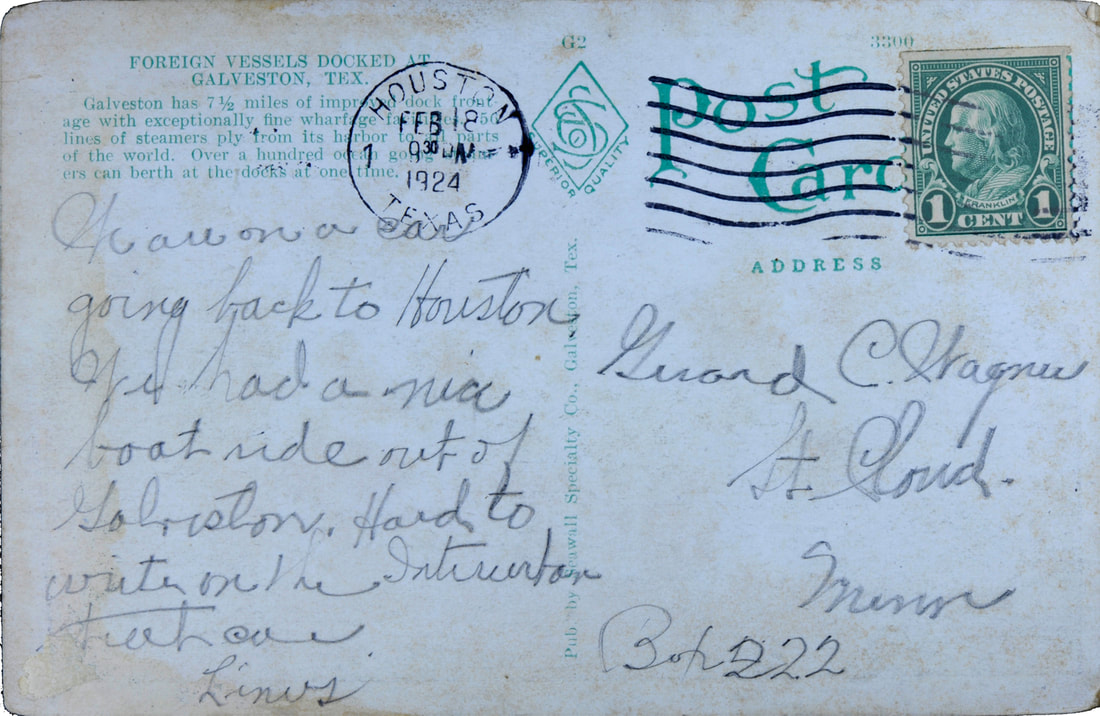Interurban Station - Banners
|
22 April 1922: Although the postcard was mailed in 1922, the image must have been taken before 1920 when a six story building, Harris Hahlo department store, was built at the northeast corner Main and Texas which would have obscured 2. and 3. [See Texas at Fannin West for a similar view and an explanation of the Uneeda Biscuit marquee sign.] 1. 1006-1008 Texas: The patriotically festooned Interurban Railroad Station made this stretch of Texas Avenue one of the busiest in town with cars leaving every hour for Galveston, a trip costing $1.25 and lasting an hour and for minutes; 2. 1002 Texas: Houston News Company managed by Louis H. Morris selling books, newspapers, magazines and souvenirs; 3. 606-8 Main: Although “Kress” remains on building façade, the 5 and dime store had vacated this location in 1913 when the new Kress Building was built at 705 Main at Capitol, and by the time of this postcard the building was used for Rialto Theatre moving pictures; 4. 600-604 Main: On the first floor, United Cigar Store, Shotwell’s clothing store and Parisian Millinery Shop, with upper floors a confectionery and a popcorn maker.
|
18 January 2014: The vacant lot here shown would not last long, and this ephemeral window on a slice of Houston’s skyline was completely filled in 2017 with the completion of the 13 level parking structure for the 48 story building at 609 Main at Texas. 1. 1000 Main: Reliant Energy Plaza, 36 floors, 2003; 2. 705 Main: St. Germain Lofts (formerly the Kress Building), 7 floors, 1913; 3. 806 Main: JW Marriott Houston (Carter Building), 17 floors in 1910, 6 more floors added in 1925; 4. 712 Main: Gulf Building, 36 floors, 1929; 5. 708 Main: The Great Jones Building, 10 floors, 1910, expanded north to Capitol Street in 1921; 6. 901 Rusk: Gulf Building Annex showing just a sliver between 4. and 7., 16 floors, 1949; 7. 600 Main: JPMorgan Chase Center, 20 floors, 1982.
|
|
Postmarked: 22 April 1922
Stamp: 1c Green George Washintgon #405 To: Mr. W. M. Combs Blackwill Okla Box 91 Message: Dear Mother This is one Great trip there is 200 of us & all stay togeather I. A. C. What event brought the author with a group of 200 visitors to Houston on 22 April 1922? The Houston Chronicle and Houston Post reveal that the 1922 San Jacinto Day celebrations on April 21st brought members of the American Legion and the Veterans of Foreign Wars to the opening of the Galveston causeway, including a parade down Broadway and festivities on the beach.
“Extra cars to accommodate the anticipated crowd will be run on the regular 2 o’clock Interurban. An extra train will be operated to the causeway at 2:30. The cars will be on hand to convey the crowd back to the city after the ceremonies are over. All of the cars will stop at the first arch on the island side of the causeway, where the ceremonies will be held. A barbecue will be given in the afternoon by the Veterans of Foreign Wars at Roger’s old location down the island. It is expected that between 1000 and 1500 former servicemen will be present.” |
The author of the card writes his mother in Blackwell, Kay County, OK to express his enthusiasm, and scrawls his brief message in a nearly illegible script. The picture side depicts the Interurban Station adorned with patriotic banners from which he may have departed for Galveston Island, and it is tempting to speculate that the postcard may have been issued to commemorate San Jacinto Day that year.
The Interurban postcard presented here was written is such a hasty manner that the closing initials are hard to interpret, but there is a way to compare handwriting from official documents available online. Before World War I American males were required to register for the draft, and the forms were signed by the registrants. There were 13 men complying from Kay County, OK, and only a single one was living in Blackwell in 1918: Irving Albert Combs, working at a flour mill and married to Flora Combs. Further researches revealed that his father was, in fact, William M. Combs. Comparison of the signatures is not entirely conclusive, but nonetheless, it seems quite likely that Irving Albert is the author of the postcard. The first record of Irving Albert Combs was in 1900 when “Irvin Combs” was a 19 year old servant living in the household of William Jones as a farm laborer. Somehow he makes his way to Hartford, Connecticut where on 28 February 1906 he married Flora Lyon, who in 1900 had been a servant living in Windham County, CT, a 17 year old girl born in the state. What brought Irving Albert to Connecticut cannot be determined. Nor is it known whether he was a soldier or veteran. He was a bit too young at 17 to have served in the Spanish American conflict in 1898, and he does not seem to have served in World War I. William M. Combs and Nancy Elizabeth “Lizzie” Morrow had five children: John Franklin Combs (1875); William H. Combs (1878); Irving Albert (1881); Frederick Francis (1882); and Lulu (1891). The family had lived in Coffee County, KS in 1880; Jackson, Lyon County, KS in 1895; Emporia, Lyon County, KS in 1900. In 1910 William M. Combs was in Enid, OK with his wife Nancy Elizabeth, daughter Lulu and her husband George A. Lee and their son Lamont. Irving Albert and Flora were also in Enid at the time, but by 1920 they had moved to Blackwell, Kay County, OK while his parents remained in Enid. The postcard was written in 1922 to Irving Albert’s parents in Blackwell, OK, so apparently they had moved there to be closer to their son. Irving Albert addresses the postcard to Mr. W. M. Combs, then “Dear Mother,” so this implies that both were still living, but no further record of them could be found. Irving Albert and Flora had three children: Ernest Lucius (1908); Harriett Anita (1910); Robert Irving (1916). About 1925 the family moved to Wichita, KS, where they remained until Irving Albert died in 1938 at 57 years of age. Thirty four years later Flora died in Honolulu, Hawaii on 10 April 1972 in her 89th year. |
|
Postmarked: 12 February 1924
Stamp: 1c Deep Green Ben Franklin #552 To: Gerard C Wagner St. Cloud – Minn Box 222 Message: We are on a car going back to Houston. We had a nice boat ride out of Galveston. Hard to write on the Interurban street car. Linus Riding on the Interurban from Houston to Galveston could be a bit of a rough ride, as this postcard from a Minnesota visitor testifies. He was from Saint Cloud, MN (named for the famous suburb of Paris), which had a population of 16,000 in 1920 when Houston’s population was 120,000. St. Cloud was 60 miles from the far larger metropolitan centers of Minneapolis (380,000) and St. Paul (235,000). Houston and the twin cities were linked by passenger and freight railroads and by river barge shipping, so travel between them was easy. The recipient of the postcard was Gerard Calistus Wagner, and his parents were John Peter Wagner and Elfrieda Margaretha Huss, both from New Reigel, Seneca County, OH where Gerard was born. His stepbrother, Linus Peter Wagner, 13 years older, was surely the author of the postcard, and another step-brother, Ralph Bernard Wagner, was already professor of rhetoric at St. Bernard’s Theological Seminary in Rochester, NY. The older boys grew up in New Riegel in Seneca County, OH, a community of 11,000 (in 1900) between Toledo and Cleveland. Settled in the 1830’s by immigrants from Germany and France, Carl Wagner (1826-1871) was an early settler there. The Wagner family members were deeply committed Catholics, and two of Carl’s daughters (Margaret “Sister Viola” and Regina) joined Ohio convents, as did Elfrieda’s sister Louise. Ralph was educated in Jesuit schools, and after teaching in Rochester, would soon find a distinguished career at Saint Louis University in Missouri. The boys’ father John Peter Wagner, was orphaned at the age of 6 by Carl’s death in 1871; his mother Catherine Kirch then married John Zimmer, but when J. P. was not quite 21 his stepfather died as well and his mother, Catherine, a widow twice, headed the family for the next 28 years. |
John Peter Wagner married Anna M. Rumschlag in 1889, and J. P. worked as host and bartender at the Palace Hotel in New Riegel. They had just two children, Ralph Bernard Wagner in 1890 and Linus Peter in 1886. The family was in crisis when In 1903 The Palace Hotel burned to the ground, and in 1907 tragedy followed when Anna died. Two years later. J. P. remarried to Elfrieda Margareta Huss and they had Gerard Calistus (1910). When Gerard was a toddler the family moved to St. Cloud where J. P. found work in the burgeoning oil business as the manager of Pure Oil Company.
Linus married Lillian Matzek on 16 September 1919 in Eau Claire, WS; she was the daughter of Joseph Matzek and Alvida “Wilda” Wang. By 1920 Linus was working as a salesman for an oil company in Minneapolis. He and his brother Ralph, also married, had served in the army during WWI, so Gerard was very much the little brother. It seems by the context of the postcard that Linus was in the Houston area with his wife Lillian, possibly on a leisure trip with perhaps some thought into new employment opportunities. Linus and Lillian bought a gas station in Wayzata on Lake Minnetonka about 15 miles west of Minneapolis, but they moved back to the Minneapolis area by 1940 and remained there through most of the rest of their lives. Linus managed their gas station and Lillian managed a beauty parlor through the early 1950’s. Their ultimate move to California and trips to Honolulu may have had something to do with Yvonne Orchard who is mentioned in obituaries as a daughter. She must have been the child of Lillian from her youth, perhaps relinquished as an infant and reunited later, but she does not appear in census records with Linus and Lillian. Linus died in 1959 in Los Angeles, Lillian died in 1965; they are buried in Live Oak Memorial Park in Monrovia, Los Angeles County, CA. Ralph Bernard Wagner died in 1973, his wife Ellen Cathleen McCormick died in 1972; they are buried in Calvary Cemetery in Toledo, OH. They had no children. Gerard Calistus Wagner married Mary Viola Cloone in 1935 in Minot, ND where Mary grew up, daughter of William and Elaine Cloone. They raised two sons in St. Cloud: William G. (1937) and John Thomas (1939). The family moved to River Forest, a western suburb of Chicago before 1950 where Gerard and Mary listed their occupation as musicians. In due course the family moved West to Los Angeles, CA. Gerard died in 1990; Mary died in 2011 at the age of 101 and was buried in Holy Cross Cemetery in Culver City, Los Angeles County, CA. |
